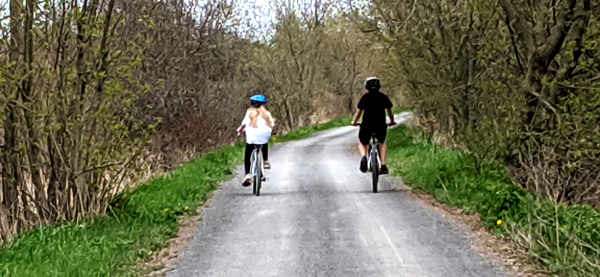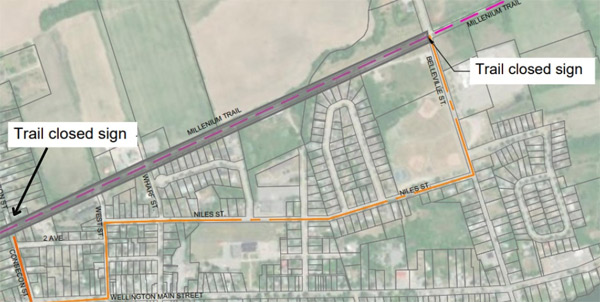Concern expressed over destruction and restoration of Millennium Trail
Administrator | Jun 03, 2025 | Comments 1

By Sharon Harrison
The impacts of construction on the Prince Edward County Millennium Trail – relating to the on-going Wellington trunk watermain and sanitary sewer project – were highlighted at council’s recent committee of the whole meeting.
Representing the volunteer-driven Prince Edward County Trails Committee, chair Gregor Stuart shared concerns of the disruption and the closure of the trail – specifically, safety aspects and detour routes, as well as poor communication from the County, and particularly concerns over the restoration of the trail and surrounding green space post-construction given the destruction incurred.
Largely, PEC Trails just wants to know when the trail will re-open, what restoration efforts are planned, and how much it is going to cost.
Interim CAO Adam Goheen recommended an information meeting to bring the various groups together to go over the trail committee’s requests, “to understand what we committed to as part of the project with engineering, talk with our own operations team, and figure out the path forward, and figure out how we are going to restore it and make it just as good or better than it was before, and on an on-going basis after the construction is done.”
 Resulting was a motion brought forward by councillor Corey Engelsdorfer that would see staff continue to work with the trails group on the restoration of the trail following construction, with a staff report to come back to council when the plan is complete, which council passed.
Resulting was a motion brought forward by councillor Corey Engelsdorfer that would see staff continue to work with the trails group on the restoration of the trail following construction, with a staff report to come back to council when the plan is complete, which council passed.
Engelsdorfer acknowledged the work and dedication that goes into maintaining the trail and noted the disappointment in the destruction that has happened on the trail.
“We really need to make sure we get it right from here on out,” said Engelsdorfer.
Councillor Roy Pennell said he would like the motion to include the financial aspect and for it to come back to council.
“All the way through, we have been kept in the dark and it’s important that we get that information,” Pennell said.
In response, councillor Janice Maynard said budget constraints are going to be part of this plan.
“Much as we’d all like to see it back exactly the way it was, somehow it will always hinge on available budget dollars,” she said, “and this may take more than few months to bring that trail back to its former glory.”
Stuart said PEC Trails wanted to recognize there is a need for change, and there has to be investment in infrastructure in order to support the growth of the County.
“The Millennium Trail itself is recognized as a utilities corridor, so we are aware of what needed to be done, and our focus from the start when we met back with planning and engineering a year-and-a-half ago, was, what is the trail going to look like after the construction.”
Stuart expressed concern at a lack of co-ordination, the failure to share of information and lack of transparency to PEC Trails (and the public and trail users) by the municipality throughout the project, citing the benefits of better communication.
Three main points of concern were raised:
-Safety during on-going construction of the trail;
-Clarification of the timing and the budget for restoring the trail to its pre-construction state, including the adjoining green space; and
-Things that the trails committee, stakeholders, residents, businesses and visitors need in order to plan for the day when the trail is restored to its pre-construction state.
SAFETY DURING CONSTRUCTION
Stuart said first and foremost was safety with respect to the trail during the construction.
“We met with engineering early in the fall to talk about signage to make sure detours were clearly marked and some effort was put into it, a PSA went out and some signs were posted, but it didn’t really stand up.”
While it was noted signs were posted at Consecon and Belleville streets, it was observed that one sign was made of paper, and another sign was toppled lying on the ground on its side, and of no use to trail users. Further, the trails committee noted how Greer Road and Hubbs Creek Road are not safe for cyclists given the state and narrowness of those roads.
Addressing safety for trail users (pedestrians, ATVs, cyclists, etc.), Stuart noted how detour signage during the construction period was strongly recommended by the trails committee when they met with engineering staff – including segregating the west side of Belleville Street.
He did note that the County’s economic development officer recently reached out and agreed to walk the trail to establish what proper signage is needed to help people get through the detour.
“It’s been a great collaborative effort working with Karen [Palmer], and it will certainly help during the busy tourist season that we are all expecting in the County.”
Stuart is satisfied the detour signage is now being dealt with satisfactorily to help mitigate safety concerns for trail users.
TIMING AND BUDGET FOR RESTORATION
The trails committee made it clear they would like to see the final budget as it pertains to the restoration of the trail.
Stuart said the trails committee were led to believe there was a preliminary budget for restoration of the trail post-construction, including replanting, but it was never shared with the committee.
“When pressed, I was told it was a preliminary budget and didn’t reflect what was actually done, and then we spent a couple of hours (myself and County staff) trying to find the actual budget, but perhaps that was not made available to the public.”
“We know how much it costs per kilometre to grade the trail back in the early 2000s, but also is the depth of the gravel going to be sufficient, but also the grading. The grading has to be such that it slopes water off, and that wasn’t mentioned.”
He also noted last-minute clearing between Cleminson Street and Wellington on the Lake was never discussed by engineering, and they cannot determine if resurfacing or planting was budgeted.
Stuart raised several other points on concern surrounding restoration, including non-compliance with the County’s tree management and preservation policy (brought to County’s attention by volunteers), where the tree policy requires staff to monitor, work and advise on non-compliance. Also, green space will only be reinstated with removed trees with topsoil and sod as per the tender, but no native grasses or plants.
It was noted that no commitment was made to ensure that sewer covers are far to the side of the trail to avoid a trip hazard or slip hazard for cyclists (also, the trail will degrade faster around sewer covers, he noted).
PROJECT PLAN FOR TRAIL (POST-CONSTRUCTION)
The trails committee require an understanding of responsibilities after completion of the construction.
Simply put, Stuart said they just want to get a firm date on when the trail and the restoration is going to be complete. He noted that all that has gone out in a PSA is, “Closed for the entire 2025 construction season”.
“Also, on the tender, there is a date mentioned of June 30 for ”substantial performance” – does that include that the trail’s finished, is it not finished, is it at the scope of that substantial performance?”
“We understand there is a plan behind this and we reached out to the project manager, saying can we see the plan – I don’t need to see the details, I don’t need to see the budget, the resources – just a rough timeline as to when the trail is going to be done.”
He said single biggest question they hear is, “When is the trail going to be restored, what’s the date, and also, what’s it going to look like?”
The PEC Trails Committee also work closely with the Prince Edward County Field Naturalists, and along with some other groups, noticed the tree policy wasn’t being followed, which he said has now been rectified, but he said the groups remain concerned of what will happen to the green space around the trail.
“From the tender, we know there is the right amount of trees, so we are comfortable with the trees, but what’s the side of the trails – what is the accompanying green space going to look like? Is it going to have native plants and grasses, or is it just going to be hydro-seeded [a process of spreading or spraying a slurry mixture of grass seed, fertilizer and mulch]?”
Final walk-through
Typically on a project like this, Stuart said a walk-through occurs near the end of the project with the contractor and all stakeholders (engineering, planning, operations, etc.), to identify deficiencies. He noted it would be a good idea to include other stakeholders, such as PEC Trails, PECFN and others, to get their input upfront to make sure that the trail is restored to what is expected.
Post completion
Post completion is another concern, where Stuart highlighted one example of the trail section between Consecon Street and Belleville Street and that they don’t know what happened to the trail, and if it was dug up.
“When it was re-surfaced as part of the whole Millennium Trail project, they had a 100 years of railbed all nice and packed down, so all they did was put 150 millimetres of finely crushed gravel,“ he explained.
“Now that has all been disturbed, there is going to be quite a bit of subsidence on that, and especially between Consecon Street and Cleminson Street, the trail is actually gone, so it is now a trench. So, the subsidence along that stretch will be significant. Who is responsible for making sure that that gets refilled, gets compacted, and maintained afterwards?”
He said, the same thing goes for the new trees. “Who is watering them, and who is watering the grass and making sure that is all looked after?”
In general, Stuart said there needs to be better communication from the municipality.
“There has been some communication come out recently, but up until then, there was not a lot going out. I think it would reduce the noise coming from all the stakeholders, residents, businesses and visitors.”
Filed Under: Featured Articles • Local News
About the Author:

































The County set aside $517,729 to the Reserve for MAT (Municipal Accommodation Tax) this year. The trail is marketed to tourists. Add this money to the trail restoration budget.